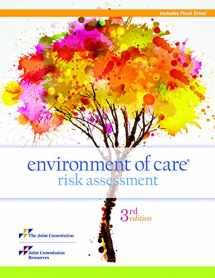
Environment of Care Risk Assessment, 3rd Edition (Soft Cover)
Book details
Summary
Description
Risk is an inevitable part life. Maintaining the safety and security of your health care organization s environment of care (EC) requires on-going due diligence typically in the form of risk assessments. Including a wide variety of staff in these assessments helps to make certain the numerous facets of the environment have been considered. Assessing EC risks in your organization is critical to ensuring the safest environment for anyone within your organization s facilities by: Determining what potential actions or situations could result in negative consequences Evaluating the scope of the identified risks Concluding whether the identified risks are acceptable or deciding safeguards should be installed to minimize and/or avoid the risk all together This revised third edition of Environment of Care® Risk Assessment introduces and discusses the various EC risk areas, as well as several risk-assessment processes. Your health care organization may use this book in the development, implementation, and/or maintenance of its comprehensive, multidisciplinary EC risk-assessment and reduction program. In addition, the text has been fully updated to reflect the adoption of the 2012 Life Safety Code® and includes a breakdown of Joint Commission survey-related processes to help you maintain survey readiness. This spiral-bound edition allows you the flexibility to take this book along as you walk through your facility assessing potential risk points, using it as a staff education tool or as an assessment tool. The included flash drive allows you to customize the tools shown in the book, which can then be used during environmental tours or mock tracers, or distributed throughout your organization to bolster the risk-assessment and reduction program. Key Topics: Risks inherent to each area of the environment of care, including safety, hazardous materials and waste, security, fire and life safety, medical equipment, utilities, emergency management, and construction Changes related to the adoption of the 2012 Life Safety Code Information about the SAFERTM Matrix and its role in risk assessment The Statement of Conditions, which is now applicable to all areas of the environment of care not just fire and life safety Best practices for maintaining a safe environment Key Features: More than 40 customizable tools, including checklists and worksheets (included on a flash drive for print version) Real-world, risk-assessment scenarios in a variety of health care settings Fresh, eye-catching infographics that visualize key ideas and facilitate understanding of core concepts Glossary of terms new to this edition Standards: EC, EM, LS Setting: Applicable to all health care setting that manage environment of care Audience: This book is meant for any staff who participates in the multidisciplinary EC risk assessment activities, including, but not limited to, safety officers, facilities managers, risk managers, security managers, emergency management leaders, clinical engineers, nurses, pharmacists, infection control personnel, and organization leaders


We would LOVE it if you could help us and other readers by reviewing the book
Book review



